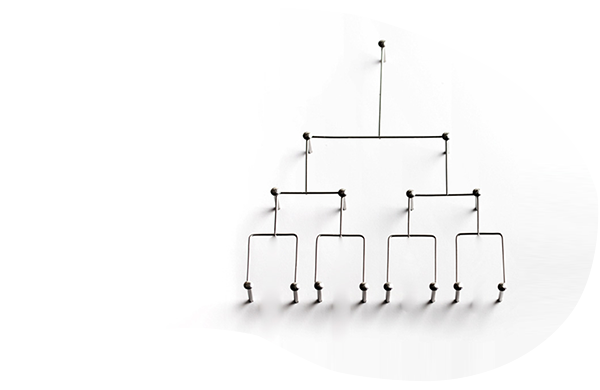In network marketing, compensation plans play a crucial role in how businesses motivate members and guide recruitment efforts. Of the many models, one may note two as the most common: Binary and unilevel plans that come with different benefits geared toward specific goals, structures of teams, and organization orientations. This guide does a really deep comparison between these two structures, pointing out the contrasts and unique qualities of both to help in choosing the apt plan for your business.
Binary compensation plan
The binary model is a two-branch system, and therefore, each participant does have to create two major "legs" or branches, which are more commonly referred to as the left and right legs. Earning potential can be maximized only when participants ensure the balanced growth of these legs because payments are usually linked to the performance of the weaker leg.
Unilevel compensation plan
In contrast, unilevel uses a much easier and more accommodating model because all direct recruits are on the same level. This means that participants can widen their networking as they wish. A broad format in this way expands the ability to recruit widely and simplifies management; recruits are in a horizontal format on the same level.
Key comparison points between binary and unilevel plans
| Criteria | Binary compensation plan | Unilevel compensation plan |
|---|---|---|
| Structure | The two-leg structure makes earnings dependent upon the balanced growth between legs. The earnings are pegged with the poorer leg. | Open-ended width; recruits are equal. Allows wide growth without leg balancing. |
| Ease of implementation and management | More complicated; needs constant monitoring and balancing of legs. Plan needs to be managed to achieve success. | Simpler installation; no need to balance the legs. Easier for new marketers to manage. |
| Pay structure | Income paid on the basis of weaker leg; balanced growth is important to achieve maximum income. | Pays across the entire down line with decreasing payout levels as depth builds. |
| Initial investment and setup costs | More expensive upfront costs due to the need for tracking and balancing technology. | Lower upfront costs; more straightforward structure with minimal tracking required. |
| Scalability and network growth | Scalable, but only if watched over constantly in order to maintain balance. Difficult when networks get large. | Scalable and without structural limitations; theoretically, networks may grow indefinitely. |
| Risk and payoff instability | It's riskier due to dependency on balanced growth between the legs; the payout depends upon the balance. | Stable income as no need for balancing; a predictable payout. |
| Ongoing maintenance and administrative costs | Generally more expensive due to the tracking of legs, technology, and support. | Generally less expensive, as there is relatively less tracking and maintenance. |
| Suitability for small teams and new members | Not so ideal for smaller teams as balancing two legs requires heavy resources. | Ideally very proper for smaller groups or new members; smooth and not too intricate to handle. |
| Long-term growth and residual income | Potential to offer long-term growth with steady effort needed for longer periods. | Ideal for long-term growth, with some residual income possible at deeper network levels. |
Structure
The two-leg structure of the binary plan makes earnings dependent on maintaining parallel growth between its two branches where compensation is calculated according to the performance of the weaker leg. This setup encourages equilibrium in both sides of the network and builds long-term stability in the network. However, it can create problems with imbalances because quick spikes in one leg limit payouts that the other leg can generate. So if participants do not balance growth between the two legs, they risk unequal rewards.
Unlike other structures, the width in unilevel is open-ended, so one may add an unlimited number of recruits into one level. Such an arrangement allows fast but wide growth without a balancing of sides, making it a huge plus in the unilevel model for companies looking for immediate huge growth. Also, this time, participants can really focus on recruitment without worrying about perfectly even structure.
Ease of implementation and management
The binary plan is a little more involved, in that the two legs of the model must be constantly monitored and leveled. There is a lot of strategy involved in this model that presents a lot of problems when a person doesn't have any experience with the binary system. Balanced management typically improves as one gains more experience or receives training from someone who understands a balanced setup.
This network is relatively simple and hassle-free to set up compared with other plans, simply because leaders do not concern themselves with balance and will work solely on getting additional new members. The system thus allows single and low volume network marketing firms with basically no administrative headaches of maintaining size at any of its entry points.
Payout structure and earning potential
Under a binary plan, you earn mainly on the output of the weaker leg, so one is encouraged to promote balanced growth on both legs for better income. In this way, those who have balanced numbers of recruits on both sides may be able to maximize their earnings. Of course, this plan only rewards people on balanced dual-sided growth but does require tracking the progress of the weaker leg.
On the contrary, the unilevel plan pays a participant over their entire downline and payout levels often decrease with depth. In this respect, this kind of multi-level payout supports a company that seeks to develop broad networks as income potential gets spread over various levels. A company interested in creating extensive networks of depth and generating residual income overtime is suited best by the unilevel model.
Initial investment and setup costs
Probably the most important consideration for the binary model is the slightly higher initial setup cost due to the requirement to monitor and maintain leg balance. It also means that two-leg format entails more resources, including tracking technology and more support to those new participants who are unfamiliar with the binary structure. Although it may be costlier to set up initially, it should support the structural requirements of the binary plan.
On the other hand, the unilevel plan is usually cheaper to operate. Its very simple structure requires minimal tracking and thus is a perfect fit for small, resource-scarce startups. It helps to cut the setup and administration costs and thus makes unilevel a very cheap option for businesses that want to enter the network marketing industry, in the easiest possible way.
Scalability and network growth
Binary plans are scalable but require continuous management to keep the proportional growth across both legs of the system, which is a tough challenge as the network increases. Balanced leg growth requirement of the binary model makes participants constantly readjust and monitor their network to avoid imbalances that might affect payouts.
The unilevel plan allows for networks to be as large as you want with no structural constraints holding you back. Since there is no width cap, participants can expand their networks infinitely. This is a workable approach for companies that intend to broaden networks with fewer restrictions unlike a binary model.
Risk and payout stability
The balanced-growth requirement also means that the binary plan bears a level of risk. Inconsistent growth in both legs can make the payouts inconsistent and sometimes result in structural imbalances between the two legs. The regular need to balance the two legs means that participants may have to cope with unstable income if one of them is doing considerably better than the other.
The unilevel plan maintains a consistent and predictable level of income. There will be no balancing acts at all. This will really smooth out the fluctuations within payouts. This is solid for those who want assured earnings. Also, network size is not limited to a certain number, meaning participants can continue to reach out with no structural limit.
Ongoing maintenance and administrative costs
The binary plan normally has higher current costs due to the leg tracking and balancing requirement. The necessity of monitoring the performance of the weaker leg means that an administration layer must be added,and can potentially increase costs more over time. Organizations focused on leveraging the potential for a binary network are often forced to invest in technology and support for its management.
With the unilevel plan, of course, maintenance is more cost-efficient. The plan's structure in a way minimizes the need for intense tracking, which in turn decreases administrative expenses. These reasons make the long run cost of the unilevel model less expensive, while reducing administrative burden on companies that focus on cost efficiency.
Suitability of smaller teams and new members
The binary model requires a lot of growth to be balanced and it is really demanding for the smaller teams or individual network marketers with limited networks. Balancing the two legs effectively would require much effort, thus the binary model is not so accessible to those who do not have substantial resources.
The unilevel plan is great for small teams and new networkers, simple and pliable. Easy management plus no balancing requirements mean smaller organizations get to grow on their timeline, steady and uncluttered, not forced into over-complexity in structures that make things confusing. With this, the unilevel plan becomes more inviting to new networkers who have just started learning or are striving to grow at a manageable size with their organizations.
Long-term growth and potential residual income
The binary plan has the advantage of showing notable long-term growth if participants can balance both legs. However, this potential requires commitment and continued effort to ensure that the expansion of both legs happens proportionately. Monitoring and strategic planning are crucial to achieving long-term success in the binary model, which is not easy for those with less resources.
The unilevel plan possesses a very broad, multilevel structure that tends to allow for long-term growth through the depth of its network. Such a structure is extremely friendly to mass recruitment and would give residual income through further development of lower levels. This is highly ideal for business enterprises interested in creating a widely spread network that can go on for some time, thus giving off a sustainable income stream in the process.
Discover how we build resilient businesses with advanced MLM functionalities
Of course, each of the two compensation plans has its respective favorites, according to different business models and growth objectives. Always weigh one against another with its strength, while keeping your final organizational goals, resources, and team dynamics in mind.
Ultimately, success in the network marketing business model has more to do with your execution than with the compensation plan adopted, and by selecting an approach which inspires greater confidence, one will watch their network grow.
- Binary plan
- Unilevel plan
- Key comparison
- Structure
- Implementation and management
- Payout structure and earning potential
- Investment and setup costs
- Scalability and network growth
- Risk and payout stability
- Maintenance and administrative costs
- Compatibility with smaller teams
- Long-term growth and potential residual income









Leave your comment
Fill up and remark your valuable comment.